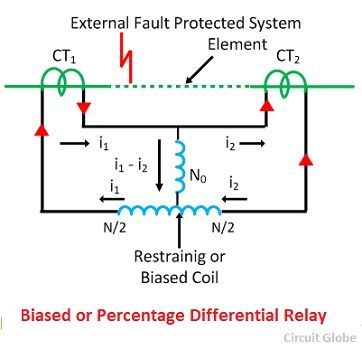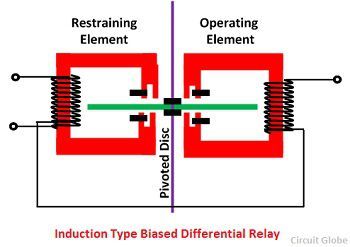Definition: The percentage differential relay is defined as the relay that operates on the phase difference of two or more similar electrical quantities. It is the advanced form of differential protection relay. The only difference between them is the restraining coil. The percentage differential relay consists restraining coil for overcoming the trouble arising out of differences in the current ratio for the high value of an external short circuit current.
The percentage differential system consists of a restraining coil connected in the pilot wire as shown in the figure below and the current induced in both the CTs flows through it. The operating coil places between the midpoint of the restraining coil.
 The restraining coil controls the sensitive characteristic of the relay. It restricts the unwanted tripping of the transformer due to the imbalance current. The restraining coil also restrains the harmonics in the inrush current.
The restraining coil controls the sensitive characteristic of the relay. It restricts the unwanted tripping of the transformer due to the imbalance current. The restraining coil also restrains the harmonics in the inrush current.
Working of Percentage Differential Relay
The torque due to the restraining coil prevents the closing of the trip circuit while the torque due to the operating coil tends to close the trip circuit contacts. Under normal operating conditions and through load condition the torque developed by the restraining coil is greater than the operating coil torque. Thus the relay remains inoperative.
When an internal fault occurs, the operating torque exceeds the restraining torque then the trip circuit contacts are closed to open the circuit breaker. The restraining torque may adjust by varying the number of turns of the restraining coil.
 The differential current required to utilise this relay is a variable quantity, due to the effect of the restraining coil. The differential current in the operating coil is proportional to (I1-I2), and the restraining coil is proportional to (I1-I2)/2 as the operating current is connected to the midpoint of the restraining coil. For external faults both I1 and I2 increase and thereby the restraining torque increase, which prevents the maloperation.
The differential current required to utilise this relay is a variable quantity, due to the effect of the restraining coil. The differential current in the operating coil is proportional to (I1-I2), and the restraining coil is proportional to (I1-I2)/2 as the operating current is connected to the midpoint of the restraining coil. For external faults both I1 and I2 increase and thereby the restraining torque increase, which prevents the maloperation.
Operating Characteristic of the Percentage Differential Relay
The operating characteristic of the relay is shown in the figure below. The above graph shows that the ratio of their operating current and restraining current is fixed percentage. This relay is also called the biased differential relay because the restraining coil is also called a bias coil as it provides additional flux.
 Types of Percentage Differential Relay
Types of Percentage Differential Relay
The percentage differential relay is mainly classified into two types. They are the
- Three terminal system application of the percentage differential relay.
- Induction Type biased Differential Relay.
Such types of relays use for the protection of generators, transformer, feeders, transmission line, etc.
1. Three Terminal System Application – This relay can be applied to the element having more than two terminals. Each of the three terminals has the same number of turns, and each of these coils develops a torque which is independent of each other. Their torques are added arithmetically.
 The percentage slope characteristic of the relay will change with the distribution of the current between the restraining coils. These relays are instantaneous or high speed.
The percentage slope characteristic of the relay will change with the distribution of the current between the restraining coils. These relays are instantaneous or high speed.
2. Induction Type Biased Differential Relay – This relay consists pivoted disc, which moves in the air gaps of two electromagnets. The portion of each pole is fitted with a copper ring. This ring can further move from, into or out of the pole.
 The disc experience two torques – one due to the operating element and other due to the restraining element. If the shading ring were in the same position of each element, then the restraining torque experienced by the ring would be zero. But if the shaded ring of restraining element was moved further into the iron core, the torque exerted by the restraining element will exceed than that of the restraining torque.
The disc experience two torques – one due to the operating element and other due to the restraining element. If the shading ring were in the same position of each element, then the restraining torque experienced by the ring would be zero. But if the shaded ring of restraining element was moved further into the iron core, the torque exerted by the restraining element will exceed than that of the restraining torque.

Explain how the percentage differential relay overcomes the draw backs of the simple differential
relay.
Please answer me on mail
Good explanation in easier way. Like it.